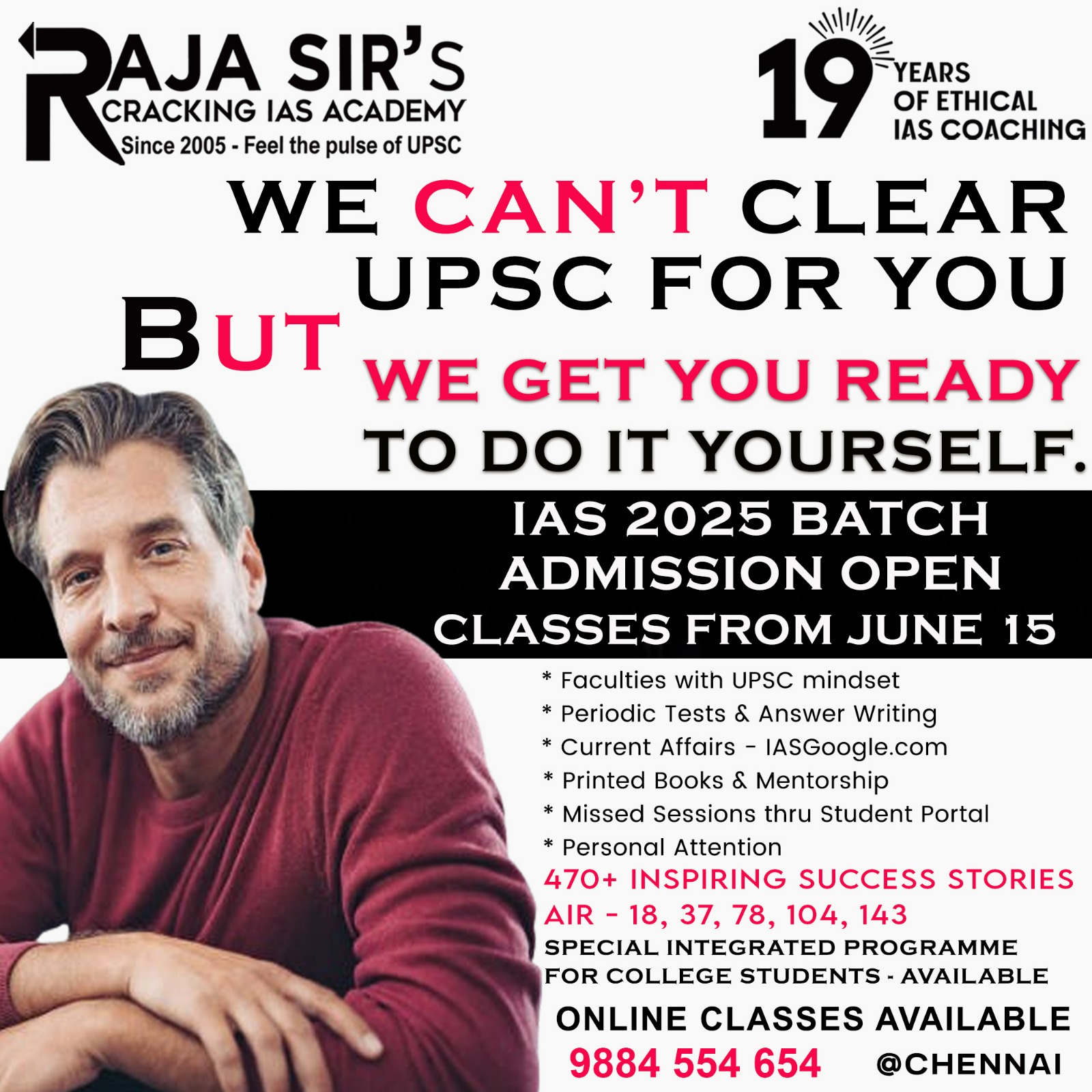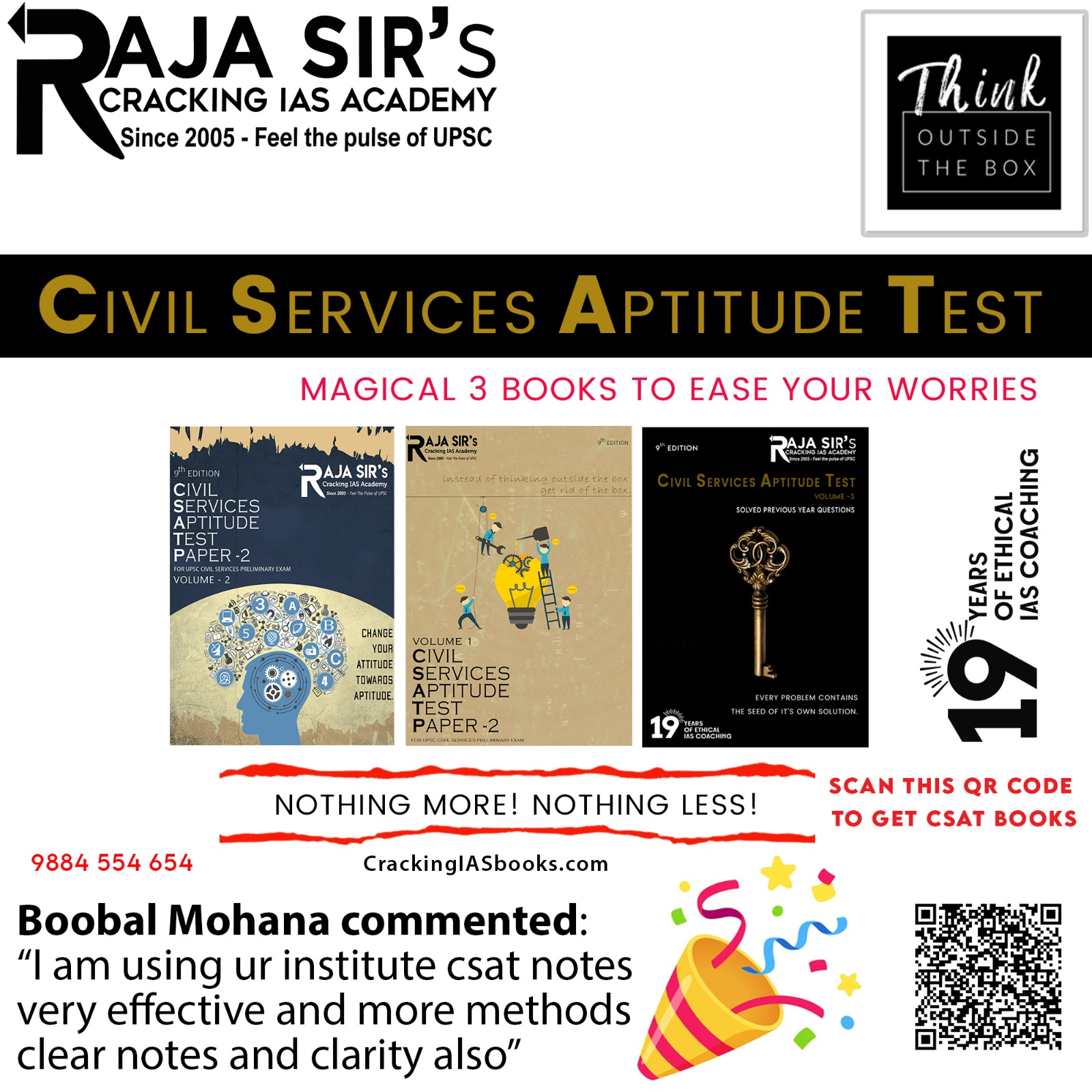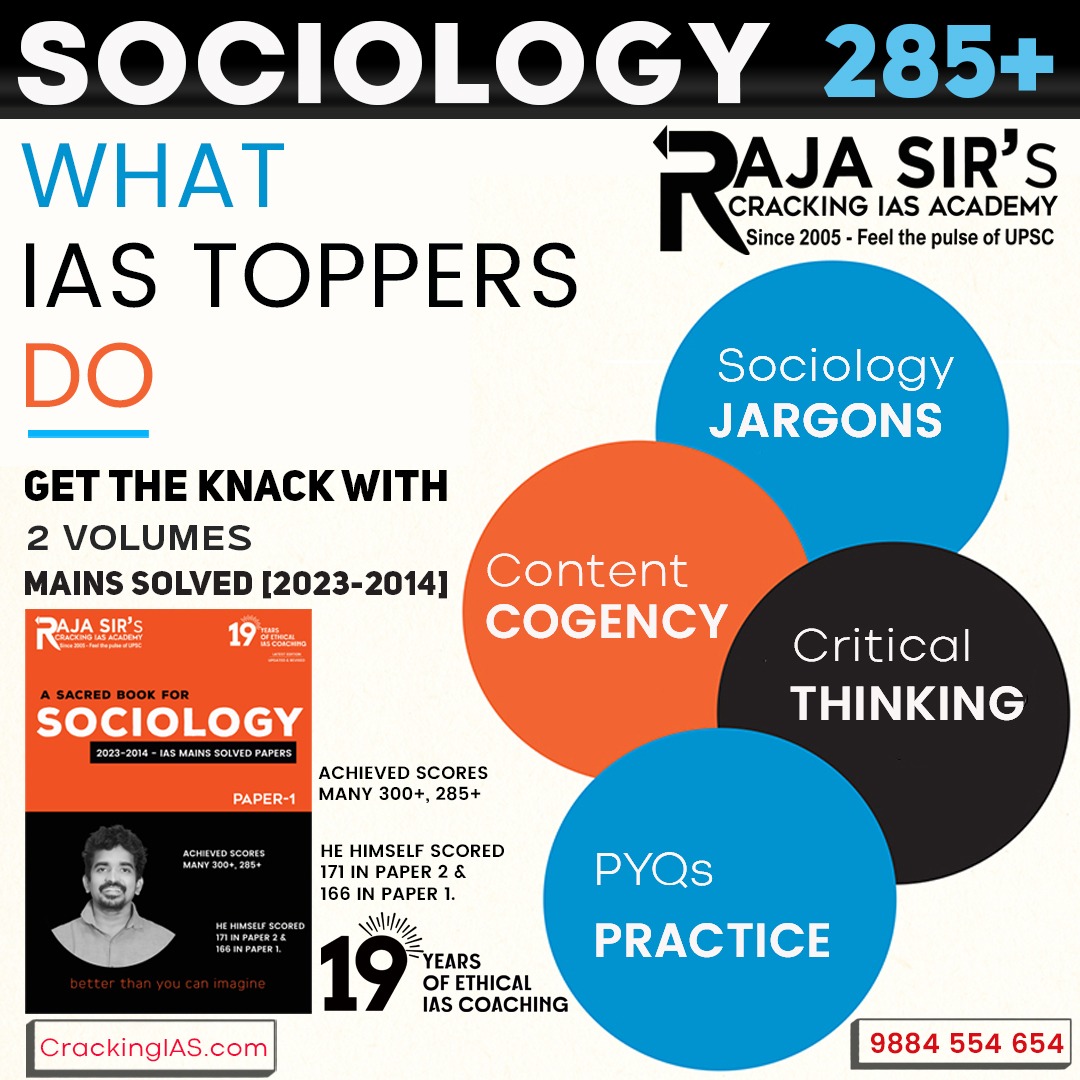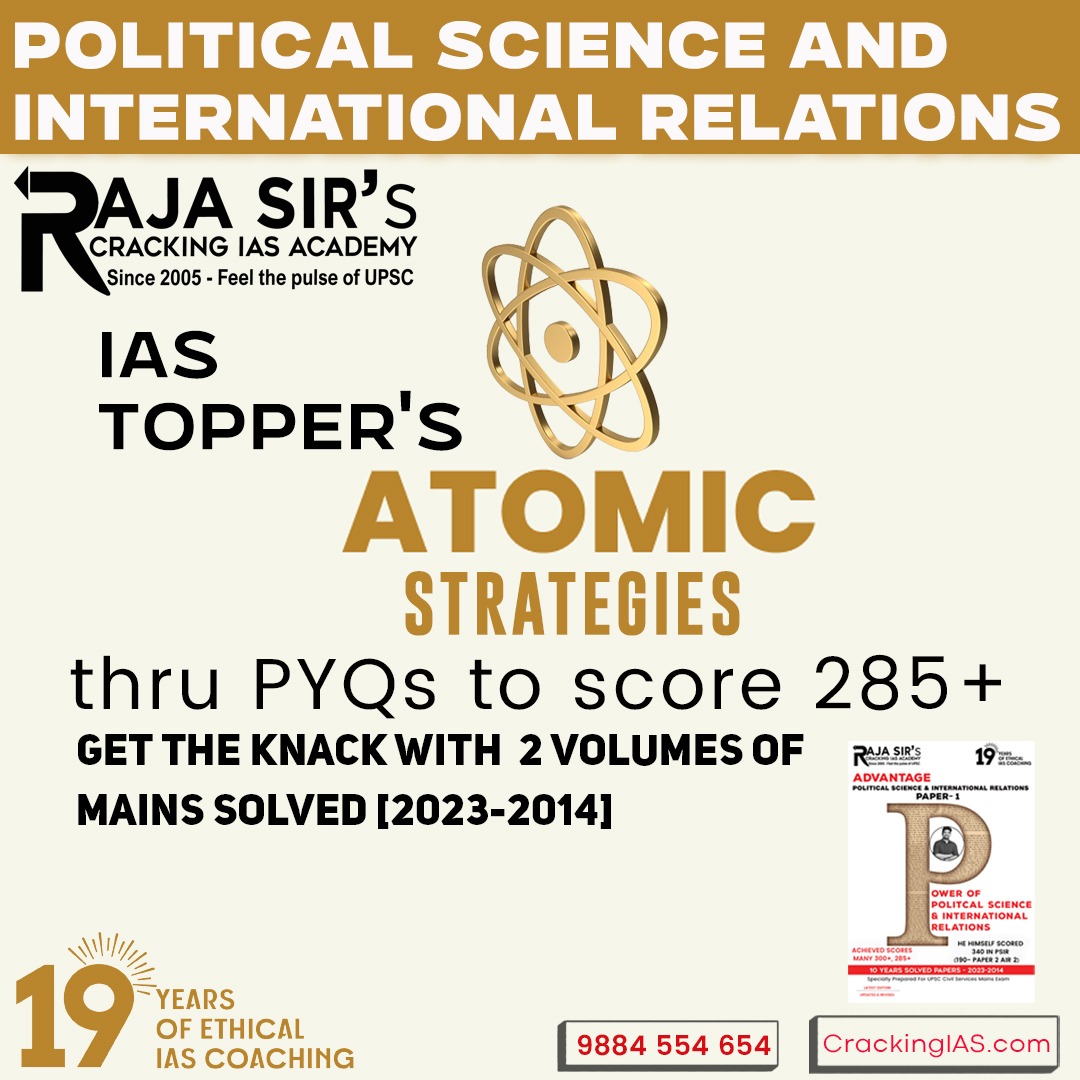- Home
- Prelims
- Mains
- Current Affairs
- Study Materials
- Test Series
 EDITORIALS & ARTICLES
EDITORIALS & ARTICLES
Hit List Questions 46-PPP 100 PRELIMS 2024 -64
Questions & Explanations:
|
|
1. |
Which of the following have been provided under the Panchayats (Extension to the Scheduled Areas) Act 1996?. 1. Reservation of seats for the Scheduled Tribes must not be less than half of the total number of seats. 2. All the seats of Chairpersons at all levels must be reserved for the Scheduled Tribes. (a) Only 2 (b) Only 1 (c) Both 1 and 2 (d) Neither 1 nor 2
|
|
||
|
|
2. |
Which of the following statements with reference to the capabilities of the Scorpene submarines is/are correct? 1. They can reach the speeds of 37 km/h when surfaced and 20 km/h when submerged. 2. They use diesel electric propulsion systems. (a) 1 only (b) 2 only (c) Both 1 and 2 (d) Neither 1 nor 2
|
|
||
|
|
3. |
With reference to the Salt Caverns, consider the following statements 1. They require a large amount of water to create and maintain. 2. They are naturally well-sealed. 3. They have low oil absorbency. 4. Its development is time consuming. Which of the statements given above is/are correct? (a) 1, 2 and 3 only (b) 2 and 3 only (c) 2, 3 and 4 only (d) 1, 2, 3, 4
|
|
||
|
|
4. |
1. Ctenophora is a phylum of exclusively marine invertebrates. 2. Ctenophores have a defined nervous system. Which of the above statements is/are correct w.r.t. Ctenophora? (a) 1 only (b) 2 only (c) Both 1 and 2 (d) Neither 1 nor 2
|
|
||
|
|
5. |
1. It is the claim line for India. 2. China considers it to be 3,488 km long. Which of the above statements is/are correct w.r.t. Line of Actual Control (LAC)? (a) 1 only (b) 2 only (c) Both 1 and 2 (d) Neither 1 nor 2
|
|
||
|
|
6. |
1. Palestine 2. Syria 3. Lebanon 4. Yemen Members of Arab League include (a) 1, 2, 3 and 4 (b) 1, 3 and 4 (c) 2, 3 and 4 (d) 2 and 4
|
|
||
|
|
7. |
Chief Justice of India DY Chandrachud said in Delhi tussle that “….the principle of triple chain of accountability will be redundant.” The triple chain of command includes 1. Civil service officers 2. Ministers 3. Parliament 4. Judges (a) 1, 2. 3 (b) 1, 3. 4 (c) 2, 3. 4 (d) 1, 2. 4
|
|
||
|
|
8. |
Consider the following statements regarding autonomous districts under the sixth schedule: 1.They fall outside the executive authority of the concerned state. 2. All the members of district council in each autonomous district is nominated by Governor in his discretion. Which of the statements given above is/are incorrect?. (a) 1 only (b) 2 only (c) Both 1 and 2 (d) Neither 1 nor 2
|
|
||
|
|
9. |
Consider the following statements w.r.t. Carbon Border Adjustment Mechanism (CBAM): 1. It bypasses the principle of ‘Common But Differentiated Responsibilities’. 2. It took effect from January 1, 2024. Which of the above statements is/are correct? (a) 1 only (b) 2 only (c) Both 1 and 2 (d) Neither 1 nor 2
|
|
||
|
|
10. |
Consider the following statements. 1. Amber Box refers to the commitments to reduce their trade-distorting domestic supports to 10% in the case of developing countries. 2. Peace clause is made for the developing countries that breach the 10 percent trade distortion without inviting any action from WTO. Which of the statements given above is/are correct? (a) Only 1 is correct (b) 1 and 2 are correct (c) Only 2 is correct (d) Neither 1 nor 2 is correct
|
|
||
|
|
11. |
I. Article 366(25) of Indian Constitution provides a process to define SCs and STs. II. Fifth Schedule deals with the administration of the tribal areas in Assam, Meghalaya, Tripura and Mizoram. III. The President of India is empowered to declare an area a Scheduled Area under Article 244(1) of Indian Constitution. IV. Article 275(I) of the Indian Constitution provides for development of infrastructure in the tribal areas. Correct statements include Codes (a) II, III and IV (b) I and II only (c) III and IV (d) I, II, III and IV o |
|
||
|
|
12. |
I. Supreme Court can directly grant a decree of divorce to consenting parties. II. The Supreme Court has extraordinary discretion under Article 142. Which of the above statements is/are true?. (a) Only I (b) Only II (c) Both I & II (d) Neither I nor II
|
|
||
|
|
13. |
Pheromones refer to (a) Hormones in Plants (b) Hormones in LGBT individuals (c) Lab made Hormones (d) None of these
|
|
||
|
|
14. |
The jurisdiction of Lok Adalats extends to 1. Labour disputes 2. Land acquisition cases 3. Family disputes (a) 2 only (b) 2 and 3 only (c) 1 and 2 only (d) 1, 2 and 3
|
|
||
|
|
15. |
Which of the FOLLOWING defines “the money given to the government when the already allocated money for expenditure for that year does not turn out to be enough and extra money is sought as provided under Article 115 of the Indian Constitution”?. (a) Excess grant (b) Supplementary Grant (c) Exceptional grant (d) Additional Grant
|
|
||
|
|
16. |
Which of the following matters has not been kept outside the functional jurisdiction of UPSC? 1. Matters related to re-employment of certain retired civil servants 2. Making reservations of appointments or posts in favour of any backward class 3. Matters of temporary appointments for period exceeding one year Select the correct answer using the codes given below: (a) 1 and 2 only (b) 2 and 3 only (c) 1 and 3 only (d) 1, 2 and 3
|
|
||
|
|
17. |
With reference to the Prevention of Money Laundering Act (PMLA), 2002, which one among the following is incorrect?. (a) It was enacted in response to India''s obligation to combat money laundering under the Vienna Convention. (b) The main motive for enacting such a legislation was to combat the crime of legalising the economic gains obtained from illegal sources. (c) The provisions of this act are applicable to all financial institutions, banks including RBI, mutual funds, insurance companies, and their financial intermediaries. (d) Serious Fraud Investigation Office has been given the responsibility to enforce its provisions.
|
|
||
|
|
18. |
1. Cellular homeostasis 2. Osmotic action 3. Muscle and nerve cell function 4. Transport of nutrients through plasma membranes India is far behind in reaching the target of the mean population sodium intake by 2025, says WHO. However, the human body requires a small amount of sodium for critical functions, Sodium intake is essential for (a) 1 and 3 (b) 1, 2, 3 and 4 (c) 1, 2 and 3 (d) 2, 3 and 4
|
|
||
|
|
19. |
1. It is based on laser manipulation and detection of neutral atoms. 2. It avoids potassium-41 atoms, which are similar to calcium-41 atoms. Which of the above statements is/are correct w.r.t. Atom-Trap Trace Analysis? (a) 1 only (b) 2 only (c) Both 1 and 2 (d) Neither 1 nor 2
|
|
||
|
|
20. |
1. Model Code of Conduct (MCC) is statutory. 2. It is in sync with the mandate that has been given under Article 324 of the Constitution. (a) Only (1) is true (b) Only (2) is true (c) Both (1) & (2) are true (d) Neither (1) Nor (2) is true
|
|
||
|
|
21. |
Applications of Raman spectroscopy include 1. to produce solar cells 2. to analyze pollutants 3. to detect for cancer 4. to identify contaminants 5. to sense the minerals in Mars (a) 1, 2, 3 and 5only (b) 1, 2 and 3 only (c) 2, 3, 4 and 5 only (d) 1, 2, 3, 4 and 5
|
|
||
|
|
22. |
Consider the following statements about the Prime Minister’s Economic Advisory Council (1) It is a non-statutory, permanent and independent body. (2) The prime aim is to analyse all the critical issues, economic or otherwise, referred to it by the Prime Minister and advising him thereon. (3) The Prime Minister is the Chairman of Prime Minister’s Economic Advisory Council. Which of the statements given above is/are correct?. (a) 1 and 2 only (b) 1 and 3 only (c) 3 only (d) 1, 2 and 3
|
|
||
|
|
23. |
Consider the following statements w.r.t. Aadhaar enabled Payment System. I. It is developed by the National Payments Corporation of India. II. Bank details are no longer required to be furnished while carrying out the financial transactions. Which of the above statements is/are true?. (a) Only I (b) Only II (c) Both I & II (d) Neither I nor II
|
|
||
|
|
24. |
Consider the following statements with respect to Geckos. 1. They are found on all the continents except Antarctica. 2. They are are nocturnal. 3. They do not lay eggs. Which of the statements given above is/are correct?. (a) 1 only (b) 1 and 3 (c) 1 and 2 (d) 1, 2 and 3
|
|
||
|
|
25. |
GST Council consists of 1. Union Finance Minister as Chairperson 2. Union Minister of State, in charge of Revenue of Finance 3.Minister in charge of finance or taxation or any other Minister nominated by each State government, as members. (a) 1, 2, 3 (b) 1 & 2 (c) 1 & 3 (d) 2 & 3
|
|
||
EXPLANATIONS
|
1. |
· According to the PESA Act, the reservation of seats in the Scheduled Areas in every Panchayat shall be in proportion to the population of the communities for whom reservation is sought to be given under Part IX of the Constitution. However, the reservation for the Scheduled Tribes shall not be less than one-half of the total number of seats. Further, all seats of Chairpersons of Panchayats at all levels shall be reserved for the Scheduled Tribes. |
c |
|
2. |
B |
|
|
3. |
A |
|
|
4. |
C |
|
|
5. |
Line of Actual Control (LAC)
LAC vs Line of Control (LoC) with Pakistan:
Disagreement over the LAC:
Why are these Claim Lines Controversial in Ladakh?
Current Arrangement to Reconcile Differences over LAC:
The Plans for Expeditious De-escalation along the LAC in Eastern Ladakh:
Legacy Issues that Need to be Resolved:
|
D |
|
6. |
A |
|
|
7. |
https://thewire.in/law/supreme-court-delhi-government-union-centre |
a |
|
8. |
|
C |
|
9. |
https://iasgoogle.com/editorial_detail/navigating-the-carbon-border-adjustment-mechanism https://iasgoogle.com/current_affair/may-27-2023-current-affairs |
A |
|
10. |
Agreement On Agriculture (AoA) § AoA is aimed to remove trade barriers and to promote transparent market access and integration of global markets. Agreement on agriculture stands on three pillars: o Domestic Support: It calls for reduction in domestic subsidies that distorts free trade and fair price. § Under this provision, the Aggregate Measurement of Support (AMS) is to be reduced by 20% over a period of 6 years by developed countries and 13% over a period of 10 years by developing countries. § Under this, Subsidies are categorized into: 1. Green Box: subsidies that do not distort trade, or at most cause minimal distortion. o They are government-funded and must not involve price support. o They also include environmental protection and regional development programmes. o “Green box” subsidies are therefore allowed without limits, provided they comply with the policy-specific criteria. 2. Amber Box: All domestic support measures considered to distort production and trade (with some exceptions) fall into the amber box as all domestic supports except those in the blue and green boxes. o These include measures to support prices, or subsidies directly related to production quantities. 3. Blue Box: This is the “amber box with conditions”. Such conditions are designed to reduce distortion. o Any support that would normally be in the amber box is placed in the blue box if the support also requires farmers to limit production. o At present, there are no limits on spending on blue box subsidies. § Market Access: Market access for goods in the WTO means the conditions, tariff and non-tariff measures, agreed by members for the entry of specific goods into their markets. The market access requires that tariffs fixed (like custom duties) by individual countries be cut progressively to allow free trade. It also required countries to remove non-tariff barriers and convert them to Tariff duties. Export Subsidy: Subsidy on inputs of agriculture, making export cheaper or other incentives for exports such as import duty remission etc are included under export subsidies. These can result in dumping of highly subsidized (and cheap) products in other country and damage domestic agriculture sector of other country. |
B |
|
11. |
https://iasgoogle.com/n/May-09-2023-current-affairs Grant-in-aid under Article 275(I) of Constitution of India provided by Govt. of India for development of infrastructure in the tribal areas. Article 244 (1) of the Indian Constitution defines Scheduled Areas as the areas defined so by the President of India and are mentioned in the fifth schedule of the Constitution. In India, there are 10 states having scheduled areas. Article 244 deals with the Scheduled and Tribal Areas. The Sixth Schedule under Article 244 (2) of the Constitution relates to those areas in the States of Assam, Meghalaya, Tripura and Mizoram which are declared as “tribal areas” and provides for District or Regional Autonomous Councils for such areas. Fifth Schedule of the Indian Constitution:
|
C |
|
12. |
C |
|
|
13. |
https://iasgoogle.com/n/May-07-2023-current-affairs Pheromones are chemicals secreted by many species of insects to attract potential mates. Insects like honey bees also use pheromones to communicate with each other. Many of these compounds have been isolated in the laboratory and are used as pest control. They lure insects into a sticky trap and reduce their spread. |
D |
|
14. |
The jurisdiction of a LokAdalat extends to the following: ü Any case pending before any court. ü Any matter which is falling within the jurisdiction of any court and is not brought before such court (i.e. disputes at pre-litigation stage). Matters under jurisdiction of LokAdalat: ü Matrimonial/Family Disputes ü Criminal (compoundable offences) cases (the jurisdiction of the LokAdalat does not extend to noncompoundable offences) ü Land acquisition cases ü Labour disputes ü Workmen''s compensation cases ü Bank recovery cases Electricity matters etc. |
D |
|
15. |
The budget contains the ordinary estimates of income and expenditure in a financial year. The parliament can make various other grants under extraordinary or special circumstances. These include:
1. Supplementary Grant: It is granted if the amount authorized by the parliament through the appropriation act to be expended for a particular service for the current financial year is found to be insufficient for the purpose of that year.
2. Additional Grant: It is granted when a need has arisen during the current financial year for supplementary or additional expenditure upon some new service not contemplated in the Budget for that year.
3. Excess Grant: It is granted when money has been spent on any service during a financial year in excess of the amount granted for that year. The demands for excess grants are made after the expenditure has actually been incurred and after the financial year to which it relates, has expired. All cases involving such excesses are brought to the notice of parliament by the Comptroller and Auditor General through his report on the appropriation accounts. The excesses are then examined by the Public Accounts Committee which makes recommendations regarding their regularisation in its report to the House.
4. Vote of Credit: It is granted for meeting an unexpected demand upon the resources of India when on account of the magnitude or the indefinite character of the service the demand cannot be stand with the details ordinarily given in an annual financial statement.
5. Exceptional Grants: It is granted for an exceptional purpose which forms no part of the current service of any financial year
6. Token Grant: It is granted when funds to meet proposed expenditure on a new service can be made available by re-appropriation, a demand for the grant of a token sum may be submitted to the vote of the House and, if the House assents to the demand, funds may be so made available.
Supplementary, additional, excess and exceptional grants and vote of credit follows the same procedure as the enactment of the budget. |
A |
|
16. |
Refer our Indian Polity Book |
C |
|
17. |
ED has been given the responsibility to enforce its provisions. https://iasgoogle.com/editorial/what-is-the-prevention-of-money-laundering-act-pmla-2002 Serious Fraud Investigation Office (SFIO) · It is a corporate fraud investigating agency set up by the Government of India. · The SFIO was established on 21st July, 2015, and operates under the Ministry of Corporate Affairs. · Section 211 of the Companies Act, 2013, accorded a statutory status to the SFIO. · Objective: The core objective of the SFIO is to be an investigative and law enforcement agency to detect and prosecute or recommend to prosecute white-collar frauds or crimes. · Types of Investigations: SFIO will usually take up the following types of cases sent by the Central Government: · Complex cases needing investigation across multi-discipline and inter-departmental affairs. · Cases with a huge monetary impact on the public. · Cases where investigation can lead to the cleaning up of systems and the implementation of changes in laws and procedures. · Serious fraud cases sent by the Department of Company Affairs. · SFIO can also take up cases on its own only when decided by the Director of the SFIO, and also giving the reasons for taking up the case in writing. · Upon assignment of a case to the SFIO, no other investigative agency can proceed with an investigation for any offence under the Act. · The Central Government can ask the SFIO to investigate a company in the following cases: · When it receives a report from the Registrar or Inspector under Section 208 of the Companies Act 2013. · When the company itself passes a special resolution and requests an investigation. · Where there is a huge monetary impact on the public or for other large-scale public interest cases. · When any Central Government or State Government department makes a request for an investigation. · Organisational Structure: · It consists of experts in the fields of accountancy, forensic auditing, law, information technology, investigation, company law, capital markets and taxation. · SFIO is headed by a Director as Head of Department in the rank of Joint Secretary to the Government of India. · The Director is assisted by Additional Directors, Joint Directors, Deputy Directors, Senior Assistant Directors, Assistant Directors Prosecutors, and other secretarial staff. · Headquarters: The headquarters of SFIO is in New Delhi, with five regional offices in Mumbai, New Delhi, Chennai, Hyderabad, and Kolkata. |
D |
|
18. |
https://iasgoogle.com/current_affair/may-22-2023-current-affairs https://enewsroom.in/india-sodium-intake-by-2025-who-salt/ According to the WHO Global Report on Sodium Intake, Reduction two million deaths can be prevented by 2025 and seven million by 2030 if policies recommended by the World Health Organization to reduce sodium intake are implemented, Key Highlights of the report:
What is Sodium?
|
B |
|
19. |
https://iasgoogle.com/current_affair/may-21-2023-current-affairs |
C |
|
20. |
It is not statutory but Political Parties, Candidates and Polling Agents are expected to observe the norms, on matters ranging from the content of election manifestos, speeches and processions, to general conduct etc.
|
B |
|
21. |
· The Raman Effect is a scattering of photon particles by molecules that encourage higher vibrational or rotational energy levels. It is also called Raman scattering. In simple words, it is a change in the wavelength of light which is caused by the rays of light being deflected by the molecules. · When a ray of light passes through a dustless and transparent sample of a chemical compound, a small portion of the light emerges in other directions than the direction of the incident ray. · The wavelength of most of this scattered light remains unchanged. · Raman spectroscopy is used in many varied fields – in fact, any application where non-destructive, microscopic, chemical analysis and imaging is required. Whether the goal is qualitative or quantitative data, Raman analysis can provide key information easily and quickly. It can be used to rapidly characterise the chemical composition and structure of a sample, whether solid, liquid, gas, gel, slurry or powder. |
D |
|
22. |
Which of the statements given above is/are incorrect?. It is a non-statutory, non permanent and independent body. Prime Minister is not the Chairman of PM-EAC. |
B |
|
23. |
C |
|
|
24. |
C |
|
|
25. |
https://www.indiatoday.in/business/story/gst-council-puts-proposal-to-vote-for-first-time-fixes-28-tax-for-lottery-across-india-1629478-2019-12-18 |
A |









 Latest News
Latest News



 General Studies
General Studies